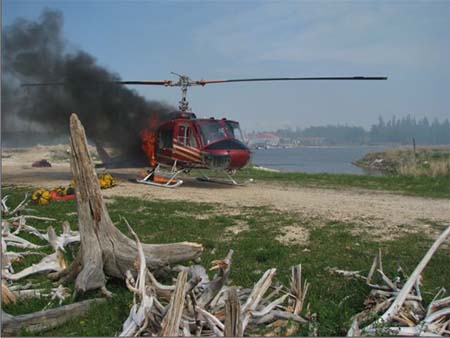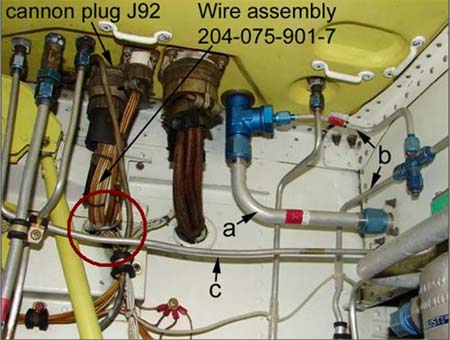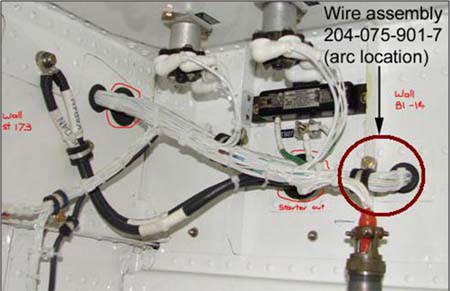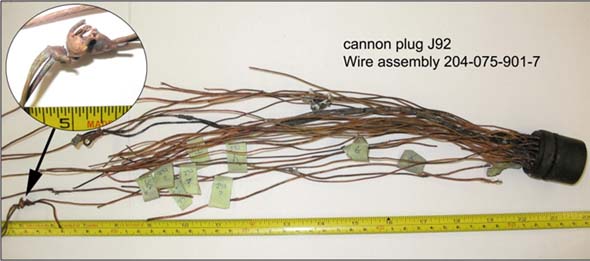In-Flight Fire
Ultra Helicopters Limited
Bell 204B (Helicopter), C-GAPJ
Easterville, Manitoba
The Transportation Safety Board of Canada (TSB) investigated this occurrence for the purpose of advancing transportation safety. It is not the function of the Board to assign fault or determine civil or criminal liability. This report is not created for use in the context of legal, disciplinary or other proceedings. See Ownership and use of content. Masculine pronouns and position titles may be used to signify all genders to comply with the Canadian Transportation Accident Investigation and Safety Board Act (S.C. 1989, c. 3).
Summary
The Ultra Helicopters Limited Bell 204B helicopter (registration C-GAPJ, serial number 2012), with two crewmembers onboard, was being used to bucket water in support of firefighting operations at Easterville, Manitoba. During a water pickup, there was an electrical burning odour followed by the illumination of a fuel boost pump caution light. The crew aborted the water pickup and transitioned back to the ground staging area approximately 100 metres away. The pilot landed the helicopter, shut off the engine, fuel, and electrics, and the crew quickly exited. Flames emanated from the right side of the engine cowling area, the fire spread quickly, and within minutes the helicopter was completely engulfed. The community fire truck was called and arrived within five minutes of the occurrence. The crewmembers were not injured, but the helicopter was completely destroyed. The accident occurred during daylight hours at 1727 central daylight time.
Other Factual Information
The nearest location providing aviation weather reports is The Pas, Manitoba, located about 65 nautical miles (nm) northwest of Easterville. The 1700Footnote 1 meteorological report for The Pas was as follows: wind 180° True (T) at 6 knots, visibility 15 statute miles (sm), rain showers, a few clouds at 4000 feet above ground level (agl), scattered cloud at 9000 feet agl, temperature 28°C. With the exception that there were no rain showers at Easterville, similar conditions prevailed at the occurrence site. The weather was not considered to be a factor in this accident.
The pilot was certified and qualified for the flight in accordance with existing regulations. The helicopter's weight and centre of gravity were within approved limits.
The helicopter had been stationed at The Pas, Manitoba and was under contract with the Government of Manitoba Department of Conservation. At approximately 1330 the pilot, along with a helicopter attack (helitac) officer and a five-person initial attack (IA) team, were dispatched to Easterville to help contain a fire that was burning near the community.
Upon arrival at Easterville, the IA team was dropped off near the fire and the pilot and helitac officer began bucketing operations while waiting for the arrival of a water bomber and birddog observation aircraft. The crew selected a water pickup point just off a point of land approximately 400 metres from the fire and had completed 31 bucket drops before the water bomber arrived. The crew then ceased bucketing operations and flew 15 minutes to Grand Rapids, Manitoba, to refuel. The helicopter had a total fuel capacity of 1600 pounds; it departed on the return flight to Easterville with 1200 pounds of fuel. When the helicopter arrived back at Easterville, the water bomber was still working on the fire and the pilot landed near the waterfront dock area to wait. At approximately 1630, the water bomber ceased operations and the helicopter crew attached the water bucket and prepared to work on the fire for another hour.
The helicopter resumed operations at 1710 and the crew dropped one bucket of water on the fire. On the return flight to the water pickup area, an electrical burning odour was briefly detected. There were no abnormal cockpit indications or cautions and the odour disappeared as the helicopter transitioned through the smoke created by the ground fire. The helicopter reached the pickup area and, as the pilot began to lower the bucket into the water, the electrical burning odour reappeared. A caution light flickered and one of the two FUEL BOOST pump caution lights illuminated. The pilot aborted the water pickup and proceeded to the ground staging area situated approximately 100 metres away. Black smoke billowed from the right rear belly area. Prior to reaching the ground staging area, a SPARE caution light illuminated and smoke in the cockpit emanated from the anti-torque pedal area. Once over land, the pilot jettisoned the water bucket and set the helicopter down. The pilot rapidly shut down the engine, turned off the fuel and electrics, and exited the helicopter with the helitac officer. At no time did the ENGINE FIRE warning light illuminate. The flames in the right engine cowling area prevented the pilot from returning to the helicopter to activate the engine fire extinguisher. The fire progressed rapidly until the helicopter was completely engulfed in flames and destroyed (see Photo 1).
The helicopter was equipped with a Guardian global positioning system (GPS)/satellite flight following system. The system provides flight and position information that is updated every two minutes. On the occurrence flight, the system was powered up at 1710, with the last recorded time at 1727.
A review of the aircraft technical records indicated that helicopter was manufactured in 1964 and had been previously extensively damaged during a helilogging accident in 1979, at total time since new (TTSN) of 3972 hours (TSB report A79P0085). The helicopter was subsequently rebuilt in 1986 and put back into service by Eagle Copters Limited (Eagle Copters). The helicopter was modified during the rebuild to include a larger 242 United States (U.S.) gallon fuel tank similar to later models. The helicopter was again modified in 1992 to include an electric siren. In 2002 it was further modified to include a Sacksafoam fire-control installation, a Bambi Bucket release, a Kenwood FM transceiver, and a utility plug.
In 2006, 680 hours prior to the accident, Eagle Copters installed a more powerful T53-13A/B engine as per Supplemental Type Certificate (STC) SH984S0. The 200-amp generator was replaced with a 300-amp generator and wire assembly 204-075-901-7, running to the engine deck cannon plug J92, was modified with wiring necessary to operate the new engine functions. Wiring in the aft electrical compartment was re-routed, terminated, and clamped in accordance with general instructions contained in publication AC 43.13-1B, Chapter 11.Footnote 2 Proper clamping, routing, and inspection of wiring are critical due to the high vibratory stresses encountered during normal flight operation.
On 15 May 2003, Ultra Helicopters Limited (Ultra Helicopters) entered into a lease agreement with Eagle Copters for the use of the helicopter. Ultra Helicopters agreed to carry out the routine maintenance and inspections of the helicopter and Eagle Copters agreed to perform major repairs, overhauls, or modifications as required. The helicopter underwent a combined 12-month annual and a 100-hour inspection by Ultra Helicopters on 17 April 2009, at 11 592 hours TTSN; the accident occurred 39 hours later at 11 631 hours.
The fuel system is comprised of two interconnected fuel cells, each equipped with an electrically operated fuel boost pump. The normal fuel pressure operating range is between 5 to 20 pounds per square inch (psi). The individual pump outlets are connected through a check valve to prevent reverse flow and a pressure switch to illuminate a FUEL BOOST caution panel light if the pressure in the lines drops below six psi. The aluminum lines are connected (teed) together by a manifold and pass through a fuel filter and an electrically operated fuel shutoff valve to a steel fuel delivery line (see Photo 2, item a). The steel fuel delivery line is located in the oil cooler blower compartment at the underside of the engine deck. An aluminum branch line (see Photo 2, item b), teed above the steel fuel delivery line, feeds fuel under pressure to the fuel pressure transmitter and provides a fuel connection for an optional heater.
The engine power turbine governor vent return line (see Photo 2, item c) is mounted in close proximity to the steel fuel delivery line. In the event of a fuel leakage inside the power turbine governor chamber, the vent line returns the fuel to the main fuel tanks. The oil cooler blower is mounted below the steel fuel delivery line and blows cooling air past the oil cooler and into the cockpit area around the anti-torque pedals. An ENG FUEL PUMP caution light is mounted on the caution panel adjacent to the RIGHT FUEL BOOST caution light. The light is set to illuminate should a pressure drop occur across the dual-element engine-driven fuel pump.
The wreckage of the helicopter was examined by TSB investigators. The cockpit and the cabin aluminum structure were completely destroyed by the fire and only the melted and burned remnants and rear portion of the tail boom remained. The engine, engine electrical harness, and the remains of the fuel system were recovered for further examination. The electrically operated fuel shutoff valve was found to be in the OFF position, as selected by the pilot after shutdown. The remaining aluminum components in the fuel system were either destroyed or too extensively damaged to assess.
The steel fuel delivery line was found to have electrical arc damage and three distinct holes burned through its outer steel wall. Strands of electrical wire were found to be arced and welded to the steel line in four separate locations. One of the arc locations was on the threads on the inside of a hex nut fitting, along with the melted remains of the aluminum fuel shutoff valve outlet fitting. The arc damage and burn through on the steel fuel delivery line was traced to contact with one of the starter/generator feed wires. The arc damage on the feed wire was at a location approximately seven inches away from the starter relay mounted in the forward electrical compartment. The arc damage was considered unusual as the steel fuel delivery line and the starter relay are mounted in separate fuselage compartments. The electrical system had been de energized by the crew after engine shutdown. The post landing fire could, however, have caused a short circuit in the ground wire controlling the battery relay, which could have re powered the electrical system.
The engine is equipped with a dual-core fire caution circuit, which did not activate during the flight. The steel-braided fuel lines in the engine compartment were examined and no anomalies were noted. No other evidence was found to indicate that the fire originated in the engine compartment.
Examination of the engine electrical harness, at the juncture of the oil cooler blower compartment and the aft electrical compartment wall, revealed electrical arcing on 19 individual wires. Eleven of the 19 arced wires were located in wire assembly 204-075-901-7 running to the engine deck cannon plug J92 (see Photos 2, 3, and 4). Four of the 11 arced wires in wire assembly 204-075-901-7 were identified as to their function.
Two of the four identified wires controlled caution lights in the cockpit, the ENG FUEL PUMP caution light and the ICE DETECTOR caution light (marked SPARE due to the disarming of the ice detector system). The location of the arc was in an area where the wire assembly passed through the bulkhead from the oil cooler blower compartment into the aft electrical compartment (see circled areas on Photos 2 and 3).
Upon entering the aft electrical compartment, the wiring bundle makes a sharp 90-degree bend before continuing on into the forward electrical compartment. Just past the 90-degree bend, the wire bundle is secured to a stiffener that is riveted to the compartment wall.
The remaining eight arced wires that were found separate from wire assembly 204-075-901-7 could not be identified as to location or function. None of the four identified arced wires in wire assembly 204-075-901-7 were associated with the wiring changes done as a result of the previous engine modification.
Analysis
The first indication for the crew of a problem in flight was an electrical burning odour, which was eventually followed by the illumination of two caution lights in the cockpit. The initial electrical burning odour was likely due to the arcing of wires in wire assembly 204-075-901-7 at the juncture of the oil cooler blower compartment and the aft electrical compartment wall. The exact cause of the wire arcing could not be determined. The smell and smoke would have been noticeable in the cockpit due to the normal flow pattern of the cooling air provided by the oil cooler blower.
The rapid progression of the fire after the initial electrical burning odour indicated that the fire likely became fed by fuel. Two possible sources of fuel in the area of the arcing were the fuel pressure transmitter and heater fuel supply line, and the engine power turbine governor vent return line. The fuel pressure transmitter line is under constant pressure and the engine power turbine governor vent line may have contained fuel, depending on the internal state of the governor. A melting, arcing, or a burn through of one or both of these lines could have resulted in a rapid propagation of the fire.
Two of the identified arced wires in wire assembly 204-075-901-7 would likely have triggered the illumination of the ENG FUEL PUMP and SPARE caution lights in the cockpit. A FUEL BOOST pump and a SPARE caution light had illuminated in flight. It is possible that the FUEL BOOST caution light could be mistaken for the ENG FUEL PUMP caution light, or that the ENG FUEL PUMP caution light had illuminated after the FUEL BOOST caution light and was not noticed prior to the pilot's rapid shutdown and exiting of the burning aircraft.
The illumination of one of the FUEL BOOST pump caution lights could, however, have occurred as a result of a drop in fuel pressure downstream of the individual fuel boost pump pressure switch. Depending on the tolerance in the setting of the individual pressure switch, a pressure drop resulting from the breaching of the fuel pressure transmitter and heater fuel supply line could have triggered the illumination of the light. Breaching of this line would result in a fuel leak in the oil cooler blower compartment as the electric fuel boost pump works to restore fuel pressure. The location of the fire, in the oil cooler blower compartment, would not initially have produced conditions that would have activated the ENGINE FIRE warning light.
The arc damage to the steel fuel delivery line most likely occurred during the post-fire collapse and destruction of the fuselage, as indicated by the arced wire on the inside threads of the hex nut fitting. The arc damage indicated that the electrical system likely became re-powered during the post-landing fire; this could account for some of the arcing found on 19 wires during the examination of the engine electrical harness.
The helicopter had been extensively repaired and modified during its 45-year history. In 2006, 680 hours prior to the accident, wiring modifications were done to the helicopter in the area of the initial arc. However, none of the four identified arced wires were traced to the modifications carried out, nor could it be determined what arcing occurred as a result of the post-landing fire. Proper clamping, routing and inspection of wiring are critical due to the high vibratory stresses encountered during normal operation. The 100-hour annual inspection carried out 39 hours prior to the occurrence should have identified any wiring discrepancies had they existed.
Due to the severe damage resulting from the fire, the origin of the wire arcing event—whether from improper routing, clamping, or unidentified wire damage—could not be determined.
Findings
Findings as to Causes and Contributing Factors
- Electrical arcing occurred in an engine electrical harness in the area of the oil cooler blower compartment and the aft electrical compartment wall. The exact cause of the wire arcing could not be determined.
- The initial electrical arcing likely breached a nearby fuel line, which led to the rapid propagation of the fire and the total destruction of the helicopter.
Other findings
- The pilot's timely decision to terminate the flight and the aircraft's proximity to a suitable landing site facilitated a successful landing.
- The location of the fire would not initially have produced conditions that would have activated the engine fire caution system.
This report concludes the Transportation Safety Board's investigation into this occurrence. Consequently, the Board authorized the release of this report on .



